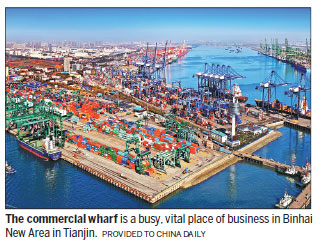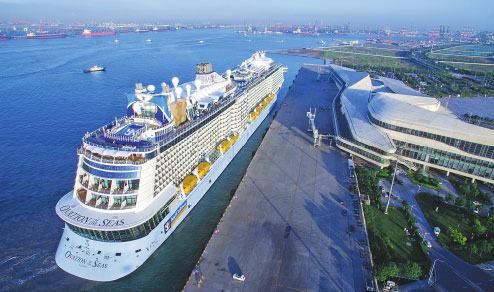
Binhai rises as economic power in just two decades
Leader in reform and opening-up reaps the benefits
The salt pans that ran along the Bohai Sea coastline some 30 years ago have been transformed via reform and opening-up into a bustling metropolis of commerce and trade - the Binhai New Area.
Ye Disheng, former director of the management committee of Tianjin Economic-Technological Development Area, a part of Binhai New Area, still remembers how shocked he was when he first visited the area in 1984.
"There was nothing but saline wasteland. I thought at least there should be some factories," Ye said.
In 2006, the area started to trial reform policies, becoming the second National Synthetic Reform Testing District, following Pudong New Area in Shanghai. As of today it has completed 90 reform trials and 175 innovations in reform.
To change its fortunes, the Binhai New Area government established philosophies of "service as a productive force", "helping companies to make money first" and "providing convenience to investors", which quickly made it a hot spot for investment.
According to official statistics from the Binhai New Area government, on average every half an hour, a company is registered there and every second, capital valued at 17,000 yuan ($2,442) is invested.
Via Tianjin Port, which is located in the district, airplanes, rockets, ships, locomotives and other high-end equipment are transported from Binhai to the outside world.
Airbus China's A320 production line has been operating in Binhai for the past 10 years, assembling some 400 airplanes.
Xu Gang, CEO of the company, told People's Daily that Airbus is confident for the cooperation with Binhai New Area for the next 10 years.
Emerging high-tech industries have also gradually replaced traditional manufacturing industries, as part of the government's effort to optimize the economic structure of the region.
Its major industries range from aerospace and biological medicine to new materials and new energy, according to Tang Zhongfu, deputy director of the development and reform commission of the area.
Rofs Microsystem (Tianjin), a local company, is developing advanced microchips as small as 1 square millimeter to be used in mobile phones and other communication products.
Zhang Guanjie, assistant to the general manager of the company, told China National Radio that annual production is expected to be valued at 10 billion yuan in the following two to three years.
By the end of 2017, Binhai New Area has 464 municipal-level and above research centers, including 111 key laboratories and 241 technological centers of companies, data from the area showed.
Binhai New Area, as the most important cluster for the manufacturing industry in northern China, has today become an advanced manufacturing base, Cong Yi, professor from the Tianjin University of Finance and Economics told Economic Daily.
|

Trees and lakes surround the buildings of Binhai New Area. The area aims to construct a livable and ecologically friendly new city.Provided To China Daily |



